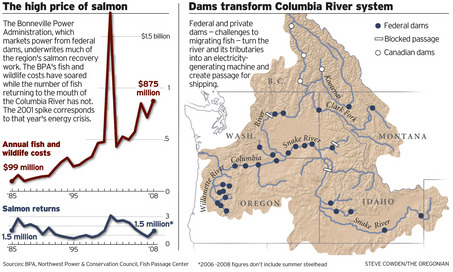forum
library
tutorial
contact

New Northwest Salmon Plan
Modifies Bush Approach
by Kim MurphyLos Angeles Times, September 16, 2009
|
the film forum library tutorial contact |

|
New Northwest Salmon Plan
by Kim Murphy |
 Reporting from Seattle - Fisheries managers announced today that they would enhance but not significantly alter the government's current strategy for saving salmon from extinction in the rivers of the Pacific Northwest, drawing criticism from conservationists.
Reporting from Seattle - Fisheries managers announced today that they would enhance but not significantly alter the government's current strategy for saving salmon from extinction in the rivers of the Pacific Northwest, drawing criticism from conservationists.
The long-awaited review left intact key components of the George W. Bush administration's controversial 2008 "biological opinion," which concluded that salmon could be kept alive on the Columbia and Snake rivers without removing dams or significantly increasing water flows.
But the plan submitted today for a federal judge's approval calls for extra measures to protect the fish -- including an additional $940 million in habitat improvements and expanded efforts to control predators and invasive species. It also proposes rigorous scientific monitoring that would automatically put into play a broad range of additional protection measures -- even removal of four dams in Idaho as a "last resort" -- if salmon and steelhead trout numbers plunged.
The four small dams on the lower Snake River stand between the salmon and millions of acres of pristine wilderness habitat. The new plan orders the U.S. Army Corps of Engineers to begin outlining the studies that would be needed to demolish them.
"We took a very good, hard look at all aspects of the biological opinion," said Jane Lubchenco, administrator of the National Oceanic and Atmospheric Administration. "We determined that the science . . . was fundamentally sound, but that there were considerable uncertainties in how all of the parts of that would play out. . . . As a result, we have brought to the table a more aggressive, a more enhanced plan that is much more precautionary."
The plan was endorsed by a coalition of farmers, utilities, ports and businesses that support maximum economic development of the rivers and their hydropower systems.
"The plan, while expensive, holds the most promise for the region to move forward collectively to do things that actually benefit fish," said Terry Flores, executive director of Northwest RiverPartners, who put an estimated $10-billion price tag on the salmon restoration measures.
The Bonneville Power Administration, which operates the biggest dams on the Columbia River, said the bulk of the costs would be paid by $100 million a year in electricity rate hikes scheduled to take effect Oct. 1.
Conservationists, however, expressed deep misgivings today over what they saw as the Obama administration's failure to make the substantial changes needed to protect the fish.
Todd True of Earthjustice, who represented fishing and conservation groups that sued over the Bush-era plan, said: "The government has failed completely to use the last four months of review for a serious, substantive or cooperative effort to build a revised plan that follows the law and the science and leads to salmon recovery. Instead . . . they are offering a plan for more planning and a study for more studying."
The Northwest's 13 stocks of endangered or threatened salmon and steelhead are a symbol of the West's once wild, free-flowing rivers and a backbone for the region's $3-billion-a-year sport and commercial fishing industry.
But taking the steps conservationists say are crucial to their survival -- funneling more water into the river instead of through electricity turbines, and removing some dams upstream -- poses formidable political hurdles. Hydropower dams provide nearly half of the region's electricity and are a crucial navigation link for barges that ferry wheat and other production from eastern Washington and Idaho to the Pacific.
Although some salmon stocks are at unusually robust numbers this year, at least one was unexpectedly low. Conservationists said the healthy returns resulted from U.S. District Judge James Redden's 2007 order that federal officials allow more water to spill into the rivers to help juvenile fish during their crucial migration to the sea.
That strategy, environmentalists said, would be rolled back under the government's latest plan. However, Brian Gorman, spokesman for the National Marine Fisheries Service, said there was no evidence that increased flows affected salmon survival, which he said was more dependent on ocean conditions.
Nicole Cordan, legal director for the Save Our Wild Salmon coalition, said conservationists also were concerned about the Obama administration's decision to adopt the current standard for measuring success -- which requires only that the fish be "trending toward recovery."
"If nothing else, this is a unique and new way of interpreting the [Endangered Species Act]," she said. "That low benchmark has never been applied before."
But Lubchenco said that the plan meets federal requirements by providing a means for the fish to survive with "an adequate potential" for recovery.
learn more on topics covered in the film
see the video
read the script
learn the songs
discussion forum
